INNOVATIVE TEACHING SHOWCASE
Empowering Teamwork and Creative Role-playing
It's about equipping students to be successful after departing WWU.
 After many years as full-time marketing executive I made a conscious and deliberate
decision to revise my career path. I moved out of an executive marketing role to
an independent practice on a part-time basis, and included teaching of the marketing
craft to my roles. My decision to teach is strongly
rooted in a desire to give back, to give much of what I have learned and entrust
it into the hearts and minds of the next generation of marketers.
After many years as full-time marketing executive I made a conscious and deliberate
decision to revise my career path. I moved out of an executive marketing role to
an independent practice on a part-time basis, and included teaching of the marketing
craft to my roles. My decision to teach is strongly
rooted in a desire to give back, to give much of what I have learned and entrust
it into the hearts and minds of the next generation of marketers.
I have had the opportunity since joining the WWU faculty to teach Marketing courses at the MBA, EMBA, and undergraduate levels, covering a range of topics including the Introductory Marketing course as well as more advanced topics.
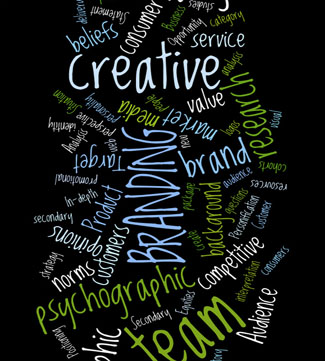 The course for which I've had the most opportunity for crafting and has sparked
the exercises which are included in the
The course for which I've had the most opportunity for crafting and has sparked
the exercises which are included in the
Students in this course are primarily seniors, although MBA students can take the course as an elective within their program. Overall course size is capped at 40 to foster an open and interactive environment.
Teaching Philosophy
I bring to my teaching craft a deep desire to instill learning and provide experiences that will prove useful to students on their professional journey. Add to that a personal bias for practicality of direction, frankness in feedback, and an ongoing presence professionally in the field I teach, and it leads to these "guideposts" for the development of my classes:
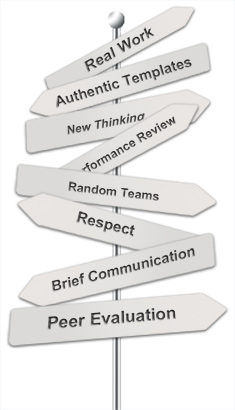
- Development of experiences and exercises that as closely as possible replicate real work and provide elements of feedback and assessment in that process.
- Teaching of technique often includes a template shared as a device to take into the world of work, with follow-up assignments delivered into that template to insure cognition of usage and applicability.
- Inclusion of the newest thinking in the field, even areas not well explored in research or publications.
- Reliance upon real life scaling in evaluation. An example? There is no such thing as A+ or 100% in the performance review process in industry.
- Development of team-based exercises often made up of randomly assigned teammates. You don't pick your teammates at work; you often don't in my classes.
- Deliberate emphasis upon respectful teamwork and term-ending queries of team performance by individuals.
- Emphasize assignment delivery on today's norms of business information delivery,
which include short presentations, quick conversations, two pagers, and email:
- Written assignments are often one pagers to emulate email. I find students are
fairly well prepared to create papers but I have used and created
no papers in the last 10 years of my career. - Speaking assignments are about engaging content, clear visuals, strong articulation and significant time compression to deliver. All delivery is timed, and presentations of too short or more often too long delivery receive poor marks.
- Written assignments are often one pagers to emulate email. I find students are
fairly well prepared to create papers but I have used and created
- Peer evaluation, particularly since the marketing profession uses this technique
in several ways:
- Given the often subjective nature of marketing projects, combining highly quantitative research, marketing strategy and art, students need to emulate the fast paced, non-defensive working environments.
- Most work environments of any discipline today utilize at least annual and sometimes
more often
360-degree feedback (i.e., feedback from colleagues as part of employee review). - For students wanting to be in either the client side or agency side of the marketing world fully 80% of the students if not more will fall into this category they will be either giving feedback within an agency, receiving it, or giving from client to agency.
- Most feedback received and delivered is
in the moment with little time for thoughtful reflection.
With this as the framework, the particular exercise that caught notice of the
A Multi-dimensional Exercise: The "Creative Brief"
The process by which brand elements are communicated to creative teams (e.g., the process by which a brand strategist figures out what they want to communicate and then how they get that to the fine folks who create, shoot, edit, and then place that Super Bowl ad we so enjoy to watch) is a critical step in the branding process. As I considered the curriculum for the Branding course, I realized that in my own career, this step of handing off strategy, research, and ideas to people whose skills are in art, layout, emotion, and entertainment was an area in which projects often stumbled. It therefore became one of the first areas I crafted in the instructional design process for the course. My practical give them skills they will use upon leaving the University mindset could not set aside this often tricky area as un-teachable; I had to find a way to provide skills and insight.
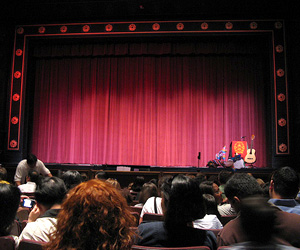 First, we learn together during the first weeks of the course about target audiences,
positioning statements, and ways to create branded communications which compellingly
translate the positioning elements to the target audience.
First, we learn together during the first weeks of the course about target audiences,
positioning statements, and ways to create branded communications which compellingly
translate the positioning elements to the target audience.
In the marketing world, the vehicle by which these elements are transferred from marketer to creative (i.e., creative marketing professional) is the creative brief. I provide to students a template of an exhaustive creative brief I have vetted with the teams at many advertising agencies. I'm confident it is too much information, but I'd rather teach the over the top version knowing that students will experience a more abbreviated version later.
It is now time for the elements of the assignment to come to life.
Teams are assigned, and are tasked with writing a creative brief for a national brand (which I've chosen and vetted; usually a couple of teams work on the same brand). Teams know that they have to deliver two things: a written creative brief which I evaluate and a presented creative brief which they will present to creatives and which will be assessed by those same creatives. In the marketing field, a creative is a professional in charge of the creative side of projects.

The creatives in my class are actually the non-presenting students, for there is much for students to learn in the role of creatives. All students are asked to bring or borrow a laptop for class on presentation day.
The elements are in place: a written document, a presentation to prepare, and students in persona playing the role of the function of people they will surely work with in their marketing careers.
I've discovered that the sequencing matters. I require the submission of the written creative brief first, and commit to 48-hour turnaround on grading. This assists teams who may have gone completely off track to course-correct before their presentation is given. Without this step, a high-point value assignment (of total course points) can go awry.
The next step is creative brief presentation day. We kick off the class with me passing out a persona (i.e., character overview in the world of acting) that students will assume as observers during the class. It assists students to "put on the shoes" of a creative person.
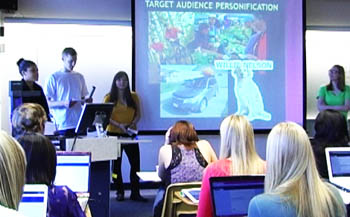
Next, I walk students through the process of data collection. They evaluate, in real time, each presentation as it is completed. They numerically evaluate three parts of the presentation:
- an overall score
- a score on how well the team connected with them as a creative
- a score on how well the national brand is translated into a local activity (a project-specific metric)
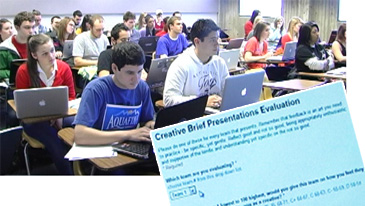
While those numbers are interesting, it is the rest of the evaluation which creates
such value: each creative must provide at least one comment of what rocked to
each team as well as at least one comment of what could have gone better. The depth of valuable feedback is stunning. Students
see in one another things I don't notice myself, in part because they want to be
thorough, but in part because they lack my experiences which blind me to certain
elements of the situation. The feedback ranges from specific slide coaching
(font size, colors) to overall idea development (e.g.,
Last of all, I remind students that in the last class we covered briefly how to give good feedback: that it is specific, that it is constructive, that it is delivered gently, and that positive specific feedback is the most precious of all.
Then, each group presents their brief for eight minutes. The time is short (and not real-world, but neither is the depth of the assignment!) and the pace is fast. Then the room goes silent for two minutes except for frantic typing as all 'creatives' provide their feedback on the team that just completed presenting. To my amusement, the dual-task nature of our students means that much of the typing actually occurs during the presentation itself, and the two minutes of feedback is often not fully utilized.
And then we race on to the next presentation!
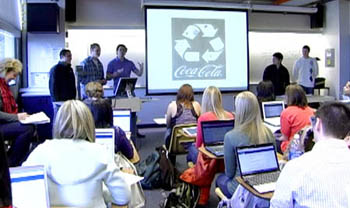
The exercise is capped off by a reflection assignment. As students depart the Creative Brief Presentation day, they are given 48 hours to write a one-pager on what they learned in the exercise. These submissions are often the highlight of the course for me as an instructor. The short timeframe keeps the observations fresh. These insights go so far beyond my hopes for the exercise that they are worthy of mention.
Yes, the students get the technique and its importance. Yes, they realize that presenting a critical branding activity to people unlike themselves is hard and important. But they also learn that they have smart classmates, tough team issues to work through, how to provide quick meaningful feedback, and for those who ask friends or relatives about the exercise, validation that it is highly emulative of the tasks they will need to do once employed in the marketing field. They learn all this because they learn it, do it, evaluate others doing it, and reflect on what they learned.
There is another element, and one perhaps instructive for my fellow teachers. I will borrow a quote from a student reflection piece, as it captures an element of context in this type of exercise I would have never figured out without student insight:
So, in conclusion:
The cycle of learn it, do it, evaluate others doing
it, reflect on what they learned has proven to be my most effective teaching technique.
It is also challenging for the students and even more challenging for me.
From the prep to structure of the exercise, to logistics of the exercise and to
multiple layers of evaluation, often under deadline, it takes a lot of time to execute
teaching in this manner. Yet the payout of proven student comprehension of the intended
objectives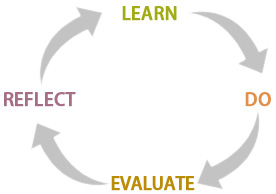 plus additional, unintended but critically valuable insights, makes the invested
time pay dividends.
plus additional, unintended but critically valuable insights, makes the invested
time pay dividends.
This exercise has been used in Branding in four separate sections (more in progress!)
After 120 successful student interactions, the methodology seems both solid and
well-tested. I have received two emails from students specifically mentioning this
exercise and its impact upon their success during their first year of work. One
person wrote to say
Where to go from here?
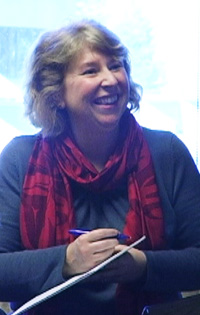
More, better, faster!
I am giggling with delight at the explosion of online reading, complete with dig intos and click heres for more insight. My hope is that this technology leap will allow students to engage further and with more impactful readings prior to classes, opening up class time to do shared learning, such as discussed here.
In the same way, I need to learn both how to create, and more importantly deploy, more one-way information that I currently deliver in the classroom through technology. Class time spent talking at students, either to assimilate or integrate different sources of ideas or to present ideas not currently available as a pre-read is not productive.
A world in which the salons of old are recreated as learning experiences seems a realistic goal for class time of the future. Whether led by students or facilitated by me, class conversations challenging ideas and pulling them together is the very best use of physical presence class time. The trick is to have enough students who have done the work ahead of time to insure adequate knowledge to have meaningful conversations; hence, my passion for learning more ways to make that happen.
Perhaps most importantly, the future for my teaching practice will be remaining
forever in 'eager student' mode. Learning from my fellow instructors whether in
structured situations as has been featured in


